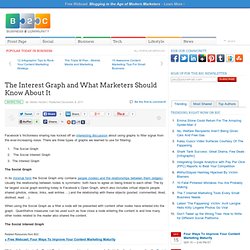

The Interest Graph and What Marketers Should Know About It. Facebook’s frictionless sharing has kicked off an interesting discussion about using graphs to filter signal from the ever-increasing noise.

There are three types of graphs we learned to use for filtering: The Social Graph The Social Interest GraphThe Interest Graph The Social Graph In its minimal form the Social Graph only contains people (nodes) and the relationships between them (edges). Usually the relationship between nodes is symmetric: both have to agree on being linked to each other. When using the Social Graph as a filter a node will be presented with content other nodes have entered into the graph.
The Social Interest Graph Related Resources from B2C» Free Webcast: Four Ways To Improve Your Content Marketing Maturity. Three Reasons to Watch Interest-Based Social Networks in 2013 - Jay Jamison - Voices. Earlier this year, I wrote about the emerging trends in social and the “Rise of Interest Based Networks.”

In my blog post, I argued that social media, like traditional media before it, was a big and broad market and would support a range of offerings beyond the “big three” social networks of Facebook, LinkedIn and Twitter. I forecast that we would see a rise in more verticalized, topic specific services. Introducing Graph Search. What is The Interest Graph? Scoop.it CEO Guillaume Decugis Shares Insights.
Guillaume Decugis couldn’t pinpoint why he wasn’t blogging.

It’s not like he didn’t want to write – being a published author has been a dream of his since he was a teenager. He had valuable insight – having co-founded and sold a $120 million mobile music delivery startup, Musiwave. “I realized I was much better at reacting to existing content and giving perspective, adding meaning,” says Decugis. Instead of forcing what wasn’t, Decugis co-founded Scoop.it, an interest-based curation platform. After signing up for an account and selecting your topic of interest, the service crawls the web for articles with relevant keywords based upon your given topic. Since it’s launch last November, Scoop.it has drawn 3 million unique visitors per month and 100,000 active users.
The concept isn’t new. “We’re looking to tie the two together. Curious to learn more about the interest graph, I sat down with the Scoop.it co-founder and CEO to dig deeper. Second, we’re seeing search becoming social. 3 Ways Taste Graphs will Fuel Social Commerce in 2012. Christian Taylor is founder and CEO of Payvment and developer of the number-one Facebook ecommerce platform for brands, agencies and merchants, and the world’s only Facebook Shopping Mall.

The early days of social commerce have mostly been about broadcasting, giving people ways to share the products they like in the hopes that their friends come back and make a purchase. The challenge here is that you’re only as good as your “graph.” In other words, if you only have 100 fans, and they each only have an average of 130 people in their social networks, how far are these shares really going to go? And in spaces like Facebook, where there are relationship-based graphs, there may not be much correlation between what your fans like and what their friends like. Enter “taste graphs,” graphs that connect people based on the things that they are actually interested in, not necessarily on their social connections alone. Here are three ways taste graphs will fuel social commerce in 2012. 1. 2. 3. My Ideal Social Network: The Interest Graph. Gravity currently maps our interests in order to target relevant content/ads.

Step in right direction, but still lots of room for innovation in presenting the data in a more meaningful and digestible way. It has now been a year and a half since I graduated college. Surprising how much life can change in such a little amount of time. My priorities, ambitions, interests, career goals, etc. are all much different from when I was a freshman at Yale. Levchin and Gurley Say That Next Big Company Will Capture The Interest Graph. Yesterday, at the Goldman Sachs Technology and Internet Conference in San Francisco, Googler and PayPal founder Max Levchin and Benchmark GP Bill Gurley discussed “game-changing technology” and the future of the Web.

Emblematic of today’s mindset, they attacked this rather large topic by comparing the strengths and objectives of Google and Facebook, using the latter’s jaw-dropping stats (500+ million users, 1 in every 13 people on Earth logs into Facebook each day) and its promotion of the social graph as a measure of what’s to come. Levchin said that Facebook is fast becoming the new social white pages, i.e. when you don’t know where someone is on the Web, you go to Facebook to find and connect with them.
But, in addition to that, he says, the social networking giant is really “the rich white pages,” where you not only locate someone but have the added benefit of finding out what they like, what they read, what their favorite movies are, and so on. 5 Ways The Consumer 'Interest Graph' Will Transform The Web. 5 Key Components of a Successful Interest Graph.
Moataz Rashad is an entrepreneur and advisor to a few startups.

He is founder and CEO of Vufind Inc. and the publisher of VuHunt, a mobile geoSocial real-life game. The interest graph has been gaining increased attention over the past few months. With Google transforming itself into a social company, and even pushing personalized search, it's clear that the curated web is a reality.